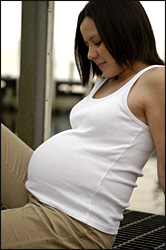
Preeclampsia is a disorder of pregnancy that strikes without warning. The condition results when pregnant women develop high blood pressure and protein in the urine. Preeclampsia is estimated to complicate from 3 to 5 percent of all pregnancies.
Untreated, severe preeclampsia can progress to eclampsia—dangerously high blood pressure and convulsions—which may result in disability or death for the mother. The only treatment for severe preeclampsia is immediate delivery of the baby. If preeclampsia occurs early in pregnancy, inducing labor will result in an infant being born prematurely, which increases the chances for lifelong disability or death.
In the United States, where treatments are available, few women die from preeclampsia itself. But, complications (such as kidney failure, hemorrhage, and stroke) from preeclampsia can lead to lasting health problems. In less industrialized nations, preeclampsia is one of the leading causes of maternal death, responsible for an estimated 75,000 deaths each year.
The NICHD has been conducting and supporting research on preeclampsia for decades, trying to zero in on the condition’s cause, which could help lead to a cure or to preventing preeclampsia from occurring in the first place.
Recent studies, conducted by a team of researchers from the National Institutes of Health and Beth Israel Deaconess Medical Center, seem to be a step in the right direction. High levels of two proteins in the blood of pregnant women appear to indicate the subsequent development of preeclampsia. The proteins, which interfere with the growth and function of blood vessels, also signal the development of high blood pressure during pregnancy.
"This finding appears to be an important step in developing a cure for preeclampsia,” said Elias A. Zerhouni, M.D., Director of the National Institutes of Health. “It may also provide the basis for predicting whether or not a woman will develop the disorder."
For a complete description of this new research finding, visit http://www.nichd.nih.gov/news/releases/Pages/preeclampsia_endoglin.aspx.
For background on this research, visit Preeclampsia Backgrounder. You can also visit PubMed to access the abstract and original article. (Please note that a subscription to the journal may be required for access to the full text of the article.)
In addition, The New Yorker magazine recently published an article about preeclampsia research. You can access this article at http://www.newyorker.com/archive/2006/07/24/060724fa_fact  .
.
The NICHD also provides general health information on preeclampsia/eclampsia elsewhere on this Web site.
Listen to an interview with Richard Levine, M.D., M.P.H. (MP3 - 3.46 MB)
Originally Posted: September 6, 2006

 BACK TO TOP
BACK TO TOP